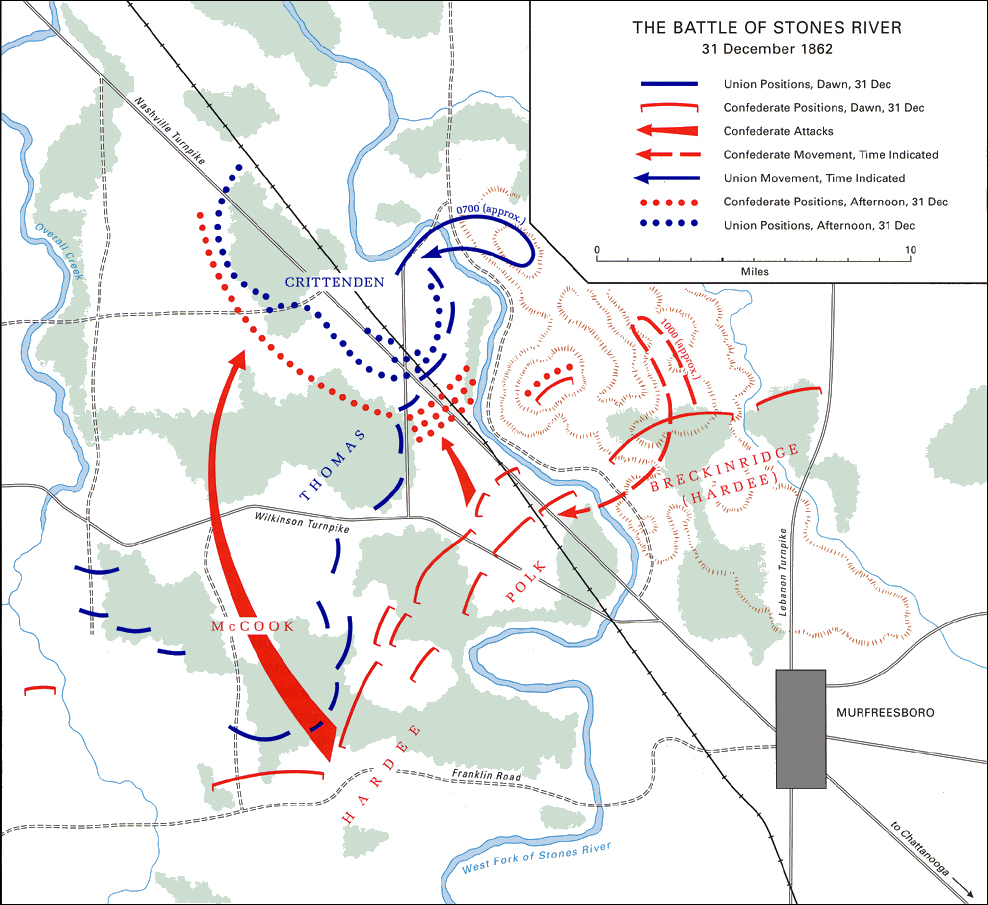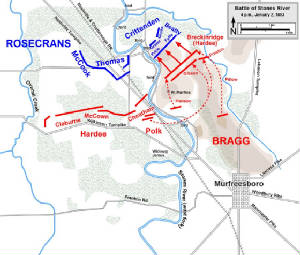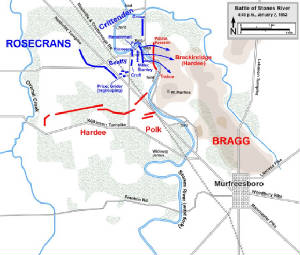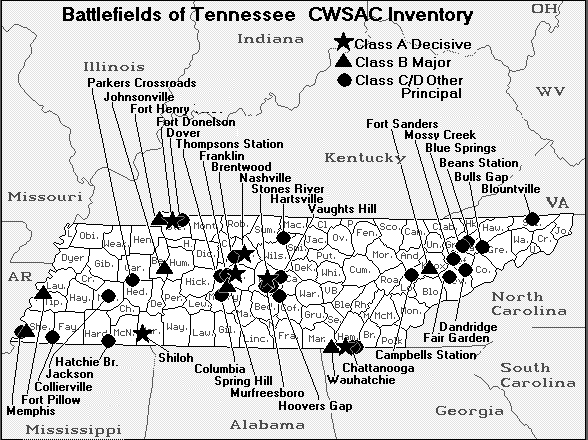
|

|
Battle of Stones River: Civil War Tennessee
Introduction
The Battle of Stones River, fought December 31, 1862–January 2, 1863,
hosted the 7th most casualties during the four year Civil War (1861–1865). While some would refer to the location as the Battle of Stones River, others
would merely call it the Battle of Murfreesboro, but both sides would mutually agree on the nature and outcome of the
fight itself - it was hell.
During the Civil War, Union strategies varied. An early strategy, meant
to contain the armies of the South, involved dispersing small contingents of troops around the 6,000 miles of land and water
borders of the Confederacy. When that strategy seemingly faltered, the Northern armies and river navies decided to break through
Southern defenses along a 400-mile front in Tennessee and Kentucky. In mid-February 1862, the Union army in Tennessee, under
Brigadier General Ulysses S. Grant, captured two strategic forts, Fort Henry on the Tennessee River and Fort Donelson on the
Cumberland River. Later that month, Union troops captured Nashville without a shot, and the first Confederate state capital
fell. In April Grant won again at Shiloh. In October Confederate leader General Braxton Bragg aborted his once promising Kentucky
campaign and settled at Murfreesboro, Tennessee, for the winter. Union General William Rosecrans followed Bragg from Kentucky
as far as Nashville. The two armies were fighting for control of middle Tennessee’s railroads and rich farms. On December
26, 1862, General Rosecrans and his army left Nashville with the intention of sweeping Bragg and his army aside and continuing
on to Chattanooga. As the Union troops neared Murfreesboro, the scene was set for a bloody battle that both sides would claim
as a victory, but which would be remembered by the ordinary soldiers as a hell.
In total*, more than 23,000 soldiers were killed, wounded,
missing or captured. The Union army suffered approximately 1,700 killed, 7,800 wounded, and 3,700 missing--a total of
13,200 casualties from an army estimated to number 41,400. The Confederate casualties included 1,300 killed, 7,900 wounded,
and nearly 1,000 missing for a total of 10,200 out of an estimated army of 35,000.
| Battle of Stones River, aka Stones River Campaign |

|
| Battle of Stones River, Tennessee, Map. Courtesy army.mil |
Summary
The Battle of Stones River or Second Battle of Murfreesboro (in the South, simply the Battle
of Murfreesboro), was fought from December 31, 1862, to January 2, 1863, in Middle Tennessee, as the culmination of the Stones River Campaign in the Western Theater of the American Civil War. Of the major battles of the Civil War, Stones River had the highest
percentage of casualties on both sides and it is listed as one of the Ten Bloodiest and Costliest American Civil War
Battles. Although the battle itself was inconclusive, the Union Army's repulse of two
Confederate attacks and the subsequent Confederate withdrawal were a much-needed boost to Union morale after the defeat at
the Battle of Fredericksburg, and it dashed Confederate aspirations for control of Middle Tennessee.
Union Maj. Gen. William S. Rosecrans's Army of the Cumberland marched
from Nashville, Tennessee, on December 26, 1862, to challenge General Braxton Bragg's Army of Tennessee at Murfreesboro. On
December 31, each army commander planned to attack his opponent's right flank, but Bragg struck first. A massive assault by
the corps of Maj. Gen. William J. Hardee, followed by that of Leonidas Polk, overran the wing commanded by Maj. Gen. Alexander
M. McCook. A stout defense by the division of Brig. Gen. Philip Sheridan in the right center of the line prevented a total
collapse and the Union assumed a tight defensive position backing up to the Nashville Turnpike. Repeated Confederate attacks
were repulsed from this concentrated line, most notably in the cedar "Round Forest" salient against the brigade of Col. William
B. Hazen. Bragg attempted to continue the assault with the corps of Maj. Gen. John C. Breckinridge, but the troops were slow
in arriving and their multiple piecemeal attacks failed.
Fighting resumed on January 2, 1863, when Bragg ordered Breckinridge to assault the well-fortified
Union position on a hill to the east of the Stones River. Faced with overwhelming artillery, the Confederates were repulsed
with heavy losses. Aware that Rosecrans was receiving reinforcements, Bragg chose to withdraw his army on January 3 to Tullahoma,
Tennessee.
| Stones River Battle Map |

|
| Civil War Stones River Map |
| Stones River Battlefield Map |

|
| Civil War Stones River Map |
Total casualties* in the battle were 24,645: 12,906 on the Union side and
11,739 for the Confederates. Considering that only about 76,400 men were engaged, this was the highest percentage of killed
and wounded of any major battle in the Civil War, higher in absolute numbers than the infamous bloodbaths at Shiloh and Antietam
earlier that year. Four brigadier generals were killed or mortally wounded: Confederate James E. Rains and Roger W. Hanson;
Union Edward N. Kirk and Joshua W. Sill.
The battle was tactically inconclusive, although Rosecrans claimed a
victory since Bragg withdrew first from the battlefield. Bragg received almost universal scorn from his Confederate military
colleagues; only the support of Joseph E. Johnston and President Jefferson Davis's inability to find a suitable replacement
saved his command. But a case can also be made that Stones River was in fact a strategic Union victory. The battle was very
important to Union morale, as evidenced by Abraham Lincoln's letter to General Rosecrans: "You gave us a hard-earned victory,
which had there been a defeat instead, the nation could scarcely have lived over." The Confederate threat to Kentucky and
Middle Tennessee had been nullified, and Nashville was secure as a major Union supply base for the rest of the war.
Rosecrans spent five and a half months reinforcing Murfreesboro. The
massive earthenworks "Fort Rosecrans" was built there and served as a supply depot for the remainder of the war. The next
major operation, the Tullahoma Campaign, did not come until June, when Rosecrans finally moved his army against Bragg.
Part of the site of the Battle of Stones River and Fort Rosecrans is
now Stones River National Battlefield. It contains the nation's oldest intact Civil War monument, erected by William Hazen's
brigade at Hell's Half Acre. The 600 acre National Battlefield includes Stones River National Cemetery, established in 1865,
with more than 6,000 Union graves. See also Tennessee Civil War History.
*Depending on the source, total casualties for the Battle of Stones River
vary slightly.
| Stones River Civil War Homepage |

|
| Battle of Stones River Map |
Sources: Stones River National Battlefield, Library of Congress; Official
Records of the Union and Confederate Armies; National Park Service; National Archives.
Return to American Civil War Homepage

|

|

|

